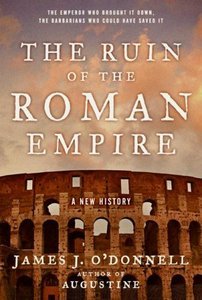
The Ruin of the Roman Empire
James J. O’Donnell
436 pages including index and notes
published in 2008
A few years ago I became interested in Roman history, especially with the later Roman Empire, what historians now call Late Antiquity, the period during which Rome supposedly fell. Supposedly fell, as the simple history we’ve been taught in school of barbarian invasions from the fringes of the Empire finally overrunning its heartlands, looting Rome and deposing the last true Roman Emperor in 476 CE, is of course wrong. That story is an invention, largely created by, as James J. O’Donnell put it, “a short, fat man”, Edward Gibbon, in his famous Decline and Fall of the Roman Empire, which codified this standard history of the fall of the Roman Empire. It was challenged in the early seventies, most famously by Peter Brown’s The World of Late Antiquity, as new research and new generations of historians started to question this old story. They found a Roman Empire and world that was severely challenged in the fifth century CE, but much more continuity between the old classical world and the new dark ages than there had been room for in the standard model.
Fast forward a few decades and the revisionists themselves are being corrected by later generations of scholars, e.g. in the books of Peter Heather and Bryan Ward-Perkins I’ve reviewed before. James O’Donnell’s entry on the subject, The Ruin of the Roman Empire is the most idiosyncratic so far I’ve read, aptly summed up by its subtitle: “The emperor who brought it down. The Barbarians who could’ve saved it.” The emperor is Justinian I, who wanted to make the empire whole again, the barbarians the supposed invaders who had taken over its western provinces. O’Donnell argues that if Justinian I had not tried to reconquer Italy and North Africa, but had concentrated his energies on his Eastern provinces and the border with Persia, something like the Roman Empire could’ve survived for longer than it did, if not an united Roman Empire. The fall of Rome in 476 CE was not the end of the Roman Empire.
Now read on.